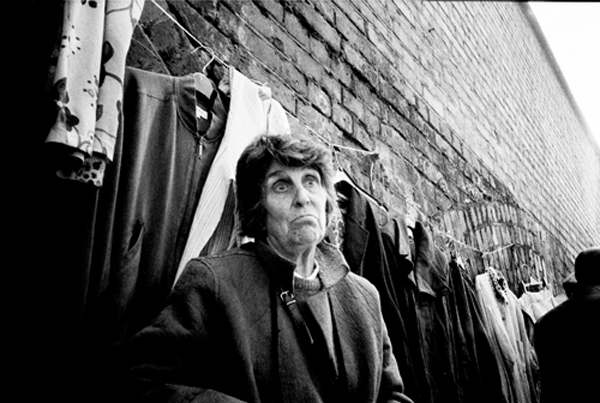Monday, 28 November 2011
'Street Photographers' a new 'magazine'

? Curated by Roger Prentice
I've just started 'curating' my 'Street Photographers'' magazine at scoop.it
The site logo is a shot of mi from a Brighton street market.
Sadler's Wells Theatre - Turnage / McGregor / Wallinger / OpenEndedGroup - UNDANCE / Twice Through the Heart
WORLD PREMIERE
//-->
A world premiere by Olivier Award-winning choreographer Wayne McGregor – “one of the most celebrated and sought-after choreographers of his generation” New York Times.
Inspired by American sculptor Richard Serra’s List of Verbs and the work of photographer Eadweard J. Muybridge, UNDANCE is about undoing, unraveling, unwinding… “I thought it would be interesting to enact these action verbs – like To Roll, To Wrap, To Slide – and not know where they are going but just do them and see what comes up – Undo them” Wayne McGregor.
Danced by ten breathtaking performers from Wayne McGregor│Random Dance, with a brand new bluesy, action-filled score by internationally acclaimed composer Mark-Anthony Turnage (Anna Nicole), UNDANCE features a set by Turner prize-winning visual artist Mark Wallinger, costumes by Moritz Junge and lighting by Lucy Carter.
For the first part of the evening, McGregor directs mezzo-soprano Sarah Connolly, immersing her in a spectacular 3D environment created by New York digital artists OpenEnded Group – in a new staging of Turnage’s emotional chamber opera Twice Through the Heart.
Both works feature a live orchestra, handpicked by Mark-Anthony Turnage and conducted by Tim Murray.
COMPASSION TEST - one of the most beautiful, moving photographs I've ever seen.

Sunday, 27 November 2011
PJ Media » The Logical Extreme of the ‘American System’
in the 1920s by H.L. Mencken in the fourth of his six-part series, Prejudices. In it, he identified the two sides of the great American experiment – our representative democratic republic and the free market capitalist system — as “the conjoined twins.” Each is wonderful and praiseworthy in its own right, but they are locked together in a way which eventually becomes toxic to both.
To read the article click on the kink
Her fourth Pullitzer Prize - Photo Journalist Carol Guzy | C-SPAN
Q&A with Photo Journalist Carol Guzy
2011 Pulitzer prize winner
Photographer Carol Guzy
Washington, DC
Sunday, May 1, 2011This weekend on Q&A, our guest is Washington Post photographer Carol Guzy.
Along with two Post colleagues Nikki Kahn and Ricky Carioti, she has just won the 2011 Pulitzer Prize for breaking news photography. They won for a series of photographs of the aftermath of the 2010 earthquake in Haiti. This is Carol Guzy’s fourth Pulitzer Prize, the most pulitzers won by a journalist.
In this interview, Guzy shows photos from the Haiti earthquake. She also discusses her past photo journalism projects including the fall of the Berlin Wall; the 1986 mudslide in Colombia; Kosovo and Albania in 1999; 9/11 in New York; and her photo story series of animals left behind after Katrina.
Carol Guzy has worked for the Washington Post since 1988. She previously worked as a photographer for The Miami Herald.
Carol Guzy is one of my favourite journalistic photographers.
Click on link to find out more.
Friday, 25 November 2011
Wednesday, 23 November 2011
Swedish Nature Photographer Exposed as Giant Photoshopping Fraud
Swedish Nature Photographer Exposed as Giant Photoshopping Fraud
click on link to read the story
The beautiful Satish Kumar {morning} (1/2) - YouTube
A day with Satish Kumar, in his interview for Earth Pilgrims, part 1/2.
Satish Kumar is an Indian, currently living in England, who has been a Jain monk and a nuclear disarmament advocate, and is the current editor of Resurgence, founder and Director of Programmes of the Schumacher College international centre for ecological studies and of The Small School. His most notable accomplishment is a "peace walk" with a companion to the capitals of four of the nuclear-armed countries - Washington, London, Paris and Moscow, a trip of over 8,000 miles. He insists that reverence for nature should be at the heart of every political and social debate.
Visit his homepage at http://www.resurgence.org/
Interview by John Craig (aka Echan Deravy) of http://www.japanthropologist.com/
Tuesday, 22 November 2011
Wonderful site of street photographs by Robert M Johnson
How to kick-start funding for a movie about street photography - you to can be invoved
Joel Meyerowitz - demonstrates the essentials of Street Photography - YouTube
He's one of the main guys that inspire me.
"Photography is made up out of light and yet it is invisible. Only the camera makes it visible." - Joel Meyerowitz
Free Royalty Free Music for your YouTube Videos
Rick's site is http://music4yourvids.co.uk/royalty-free-music.html
What a great idea - thanks Rick!
Monday, 21 November 2011
Friday, 18 November 2011
UK - Check out some stuff re the unmissable 'The Killing' - series II starts this Sat - two episodes - tell your friends
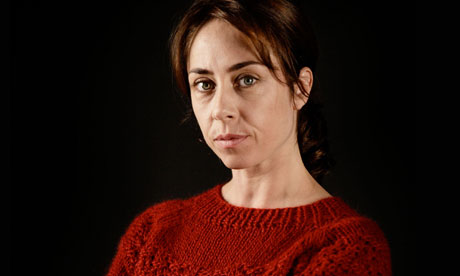
Søren Sveistrup heaves open a heavy wooden door and steps into a deserted Copenhagen police headquarters. Austere grey corridors give way to tatty interrogation rooms and lockers that have seen better days; in the main office huge bookcases are lined with files,
desks littered with paperwork and laptops. Shadows congregate in every corner.
Which is just the way Sveistrup likes it. The writer of The Killing believes a thriller should look murky round the edges and what isn't achieved via the Danish weather – currently cold, windy and desperately trying to drizzle – is suggested by the authentic and surprisingly
large set. We stroll about, pausing to chat in the meeting room, and loitering by Sarah Lund's desk........... Guardian write up by Vicki Frost HERE
William Eggleston - great article by Chris Klug
Yesterday I had one of the most moving experiences, photographically-speaking, that I’ve had in a while. I was in Chicago on business for the day. The meeting ended at 3pm, so I had a little time before I had to head back to the airport. I knew I was close by the Art Institute, so I went online to see what photography exhibit they had up. It turned out it was a show by William Eggleston entitled ‘Democratic Camera,’ so I quickly walked over to the Institute and took in the show.
For those of you not familiar with his work,
Click on link to read Chris Klug's article
Louis Daguerre: Google Doodle photography innovator's earliest surviving image - mirror.co.uk

Louis Jacques Daguerre's first surviving daguerreotype image, of a collection of plaster casts on a window ledge (Pic: Getty)
Louis Daguerre, whose 224th birthday is celebrated today with a Google Doodle, was the inventor of the first commercially successful form of photography.
The French physicist devised the daguerreotype, the process for transferring photographs onto silver-coated copper plates – although according to writer Robert Leggat, his discovery was made by accident.
Click on link to read article
101 Things I Have Learned about Street Photography — Eric Kim's Street Photography
1. Don’t worry about the camera so much, just take the damn photo.
2. Ditch the zoom lens and screw on some primes
3. Carry your camera gear in a messenger bag (it makes your camera & lenses easier to access).
4. Go for the candid look.
5. Go for the shock factor.
6. Smile often.
7. When shooting from the hip, your first 1000 shots will be terrible.
8. Don’t make eye contact with your subjects when trying to be discrete.
9. Imagine that the world is your stage and people are your actors.
10. Feel free to ask people to take their portraits.
Click on link to read the full list
Wednesday, 16 November 2011
Oh how sad I am to have missed this exhibition of 'Comrades' by Phil Maxwell

Click on link to see more wonderful work.
Go HERE - http://philmaxwell.co.uk/ - and sign up for his daily photoblog
All you budding street photographers check out PHIL MAXWELL - he's been doing it for 40+years!
Apparently the world’s first pop-up shopping mall will be assembled within the next month at the former Bishopsgate Goods Yard. The historic site will be renamed ‘Boxpark’ and will house 60 recycled shipping containers, spanning two floors. According to the advertising hype it promises to be “a radical, ground-breaking alternative to the ailing conventional high-street”. What the organisers have failed to realise is that such an alternative existed for years when every Sunday a small army of people would sell a range of clothes and household items. One of my favourite retailers was the woman below.
I love his daily pics - you can sign up on his site to get the same yourself.
Tuesday, 15 November 2011
Monday, 14 November 2011
"Security guards have no right to prevent street photography," says Home Office - British Journal of Photography
"Security guards have no right to prevent street photography," says Home Office

The Home Office and the British Security Industry Association have published a new set of guidelines for security guards confirming that photography in public places is legal and cannot be restricted
Click on link to read article
Saturday, 12 November 2011
Focus on Thomas Leuthard – Street Photographer - great interview on DPS
If you like street photography, you’ve probably heard of Thomas Leuthard. He lives in Switzerland and, although he hasn’t been on the street photography scene for very long, he’s made quite a name for himself in the community worldwide. The guy has got quite an eye! When I see his regular posts on social media, I am always astounded by the number of quality of images he manages to shoot on any given photo walk. There is something very special about his photographs, some will make you smile, others will move you. He does it out of sheer passion for the craft. He loves to roam the streets of large cities worldwide and enjoys sharing his work and knowledge through social media and workshops. His generosity has even led him to publish two fantastic e-books about street photography that are downloadable free of charge! He agreed to answer a few questions for the dPS readers. If you haven’t already done so, I urge you to check out his work by visiting his website from there you can find all the links to Thomas’ social media world.
1. When did you start doing street photography and why?
It was in May 2009 when I ordered a new Nikon 85mm prime lens and decided to make only street photos with this lens and upload it to a new online profile called 85mm. This was the start of 85mm Street Photography. The lens changed to a wider one over time, but the name remained.
Click on link for interview and more photographs
Being Stephen Shore | Photography | Agenda | Phaidon
"Part of what a photographer does is make sense of the space around them." Stephen Shore
'Part of what a photographer does is make sense of the space within them" - RP
Tuesday, 8 November 2011
Fine art photography as images that connect us to deeper meaning

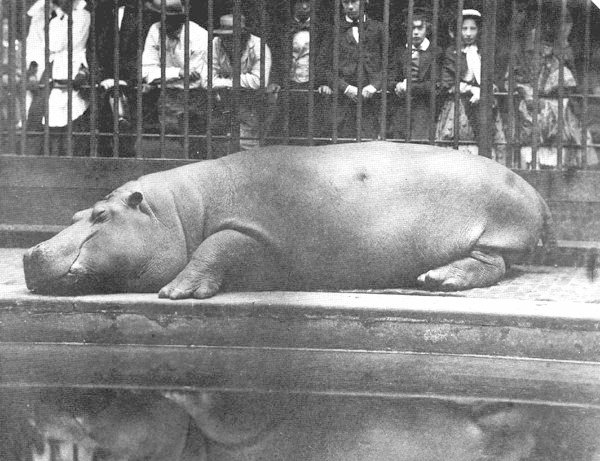

Saturday, 5 November 2011
Two outstanding photographic artists
A photograph is a distilled, charmed, disturbing, intense, and ethereal correspondence with the world: a talisman empowered by the ineluctable mystery of the visual. Tom Normand Source


Friday, 4 November 2011
Descending or not descending into hell - two photographs
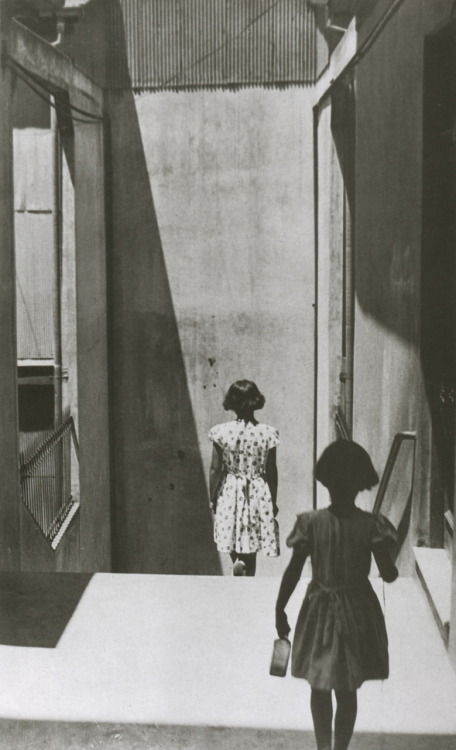
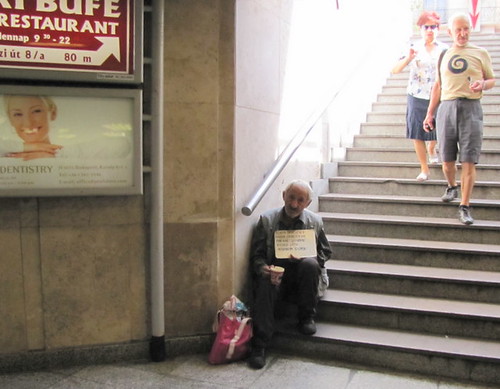
This photograph 'appeared' when travelling via the metro/underground in Budapest.
As is so often the case in 'Street Photography' I grabbed it unconsciously, like a bear mid-stream to whom the salmon leaps - snap! (Impossible lighting & v modest camera)
I didn't construct it consciously. It was a gift, not something directly worked for. I only saw it afterwards, back home.
If someone else had taken it, and I had looked at it, really looked, I would be stunned! So I will try to 'critique' it as if it was another photographer's work.
One key is the two arrows. Another is that the two men look to be the same person.
Three people. Two worlds.
The man coming down the steps - a clone or alternative version of the beggar-man at the foot of the steps?.
Perhaps they represent two parallel versions of reality as in the 1998 film Sliding Doors - except the two, and their realities, have come together at the particular moment of the photograph.
Perhaps the two are the same person who decades ago when 'Two roads diverged in a yellow wood' took the wrong road, except in a parallel reality the other road was also taken. The two versions, the two selves the two roads come together on the steps of the metro in this moment.
One is holding a cup, the other, I think, sun-glasses.
One exudes wretchedness and a hatred of the world that dealt him his deal, a world that won't fill his cup sufficient to displace that hatred? His sound is, "Ssssssssss".
Perhaps his gay/girlie pink bag is the punctum if you view the scene through Barthes-ian spectacles.
One exudes super-relaxed nonchalance. His sound is, " Hi guyyyyyyys, yo, how are y'all". (Yes, yes I know that is a mixture of out-of-dates idioms!)
Presumably he also has a cup - what does it contain? Not the dregs of bitterness.
Two descend from a world of super-brightness.
One huddles on the lower-most step.
In hell?
But which way is hell? What good is it the seduces us? The good deeds of the ordinary people are the sins of saints.
Which one is in hell, or might be tomorrow, following a turn of events?
Might their positions be reversed, if having coincided they take the next step along the journey?
Two arrows point. One points ascendingly, but not like a Zen master. One appears to point descendingly.
Which arrow is to be trusted?
Upwards there is the possibility of super-white teeth. Upwards there is a restaurant that asserts itself.
The woman is mysterious. Did she reject one, and accept the other? Is her own dual two-pathed reality about to come into a single moment? Did she turn back instead of making a choice between two roads.
Do we willingly descend?
Is hell a state of being, not a place, a state of being that we engender or step out from.
Would hell be the eternal living of the road not taken? A vision of this risk is Hirokazu Koreeda's film 'Afterlife'
Or a meeting with our 'selves', sub-personalities, that each made their own journeys and rattle and jostle our consciousness for space and time.
Are we ascending or descending?
Is the light too bright, as for eyes freed of cataracts?
Will we all realize the full consequences of choices made?
Is redemption in Abe Lincoln's home spun, "Most folks are about as happy as they make up their minds to be." Hell or heaven is the state we (choose) to live in?
Who, or what, makes up our heart-mind?
-0-
Thursday, 3 November 2011
Desperately seeking a photographic aesthetic

The Thing Itself - this I take to be the object 'out there', at least the thing that stimulated the photographer's attentionThe Detail - which part of the object is emphasizedThe Frame - what does and doesn't go inside one of the four sides of the frameTime - not just the duration of the shot but whether the photograph re-presents the passing of time as in a blurring of motion.The Vantage Point - which I take to be largely the same as PoV - point of View - high angle shot etc.
Wednesday, 2 November 2011
Pierre Beteille (Monkeyman) - a genius to rank with Cindy Sherman

I hope some museum has paid him a million dollars for a set of prints!
Go to Flickr for oceans of joy, laughter and astonishment!








